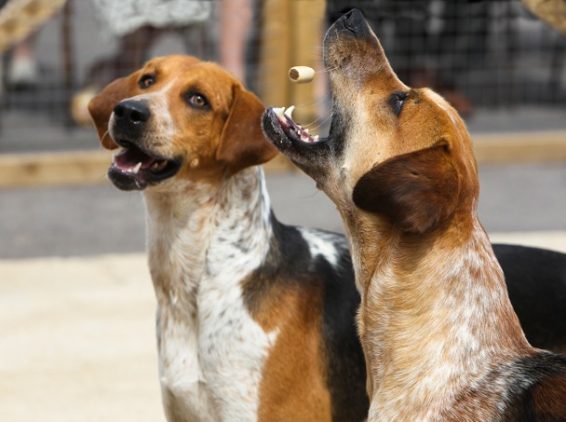The Old Berkshire Foxhounds as with any other pack are a valuable treasure and one which is irreplaceable. Careful planning regarding breeding has resulted in a workmanlike pack, which have had their fair share of success on the flags over the years.
Our hounds have a very long history, the Rev.John Loder, Rector of Hinton Waldrist and Lord of the Manors of Hinton and Longworth, kenneled his hounds at Hinton Waldrist.
The Rev. Robert Symonds took over the reins in 1800, one of seven sons, he married Rev. Loder’s daughter,he brought with him his brother Edward, who had hunted their hounds in Herefordshire and on the Cotswolds. The two packs were hunted together, the Berkshire sportsmen calling the Herefordshire hounds ‘Welsh hounds’, being smaller and slower than the original pack,
The Old Berkshire Foxhounds as with any other pack are a valuable treasure and one which is irreplaceable. Careful planning regarding breeding has resulted in a workmanlike pack, which have had their fair share of success on the flags over the years.
Our hounds have a very long history, the Rev.John Loder, Rector of Hinton Waldrist and Lord of the Manors of Hinton and Longworth, kenneled his hounds at Hinton Waldrist.
The Rev. Robert Symonds took over the reins in 1800, one of seven sons, he married Rev. Loder’s daughter,he brought with him his brother Edward, who had hunted their hounds in Herefordshire and on the Cotswolds. The two packs were hunted together, the Berkshire sportsmen calling the Herefordshire hounds ‘Welsh hounds’, being smaller and slower than the original pack, Robert Symonds claiming they had much better noses.
It was the practice at the time when a Master retired, the hounds were put up for sale, so when Mr.James Morrell became Master in 1847, he purchased 40 couple from Sir Richard Puleston (the Shropshire) these hounds were initially unsettled and the then Huntsman Will Todd, set about curing their bad habit of fighting.
Once again the pack found itself up for sale in 1858, there was much interest, including the French, 82 and a half couple made a handsome 2,581 guineas, the smart hound van alone making 65 guineas went to Berkeley Castle.
The last hound sale took place in 1866 when Mr. Greaves retired from the Mastership, bidding was poor, partly due to the fact that in their last season hounds were considered to be slack and refused to break up their foxes, this was the year of the cattle plague, when the country was in panic and severe restrictions on the movement of cattle were imposed.
Rabies was a real problem and in 1885 an outbreak occured which nearly killed all of the dog hounds, believed to have been started by a hound being bitten by a stray dog in Faringdon. This was not uncommon, in the same season some bitches were lost having been bitten by a fox in Coxwell Woods, which stood at bay!
Mr. Charles Booth Elmsall Wright became Master in 1901, he lived at New House, as so many Masters of the Old Berks had done, and still do! He improved the quality of the pack by using Milton Analyst amongst other stallion hounds from various packs, he was by Belvoir Watchman out of Grafton Agile.
Masters over the years have bred a hound to suit the country, two notable hound breeders of more recent times being Major Bill Scott and Mr.Colin Nash. Some notable stallion hounds were bred by these two Masters, Partner’57, Playfair’60, Tewkesbury ’61 and Grammar ’61 being only a few, which were used extensively by other packs.In fact in the 1963 edition of the Foxhound Kennel Stud Book, Playfair ’60 sired six litters at home, a doghound that was obviously thought a lot of.
More recent influences have been an outcross to a pure Welsh bitch Pembrokeshire Gignog ’97, which proved an outstanding success, the whole litter being very good in their work, this summer another dose of pure Welsh blood has been introduced through Cwrt Y Cadno Brandy ’09, who has reared a litter by Darlington ’12, to hopefully simulate the same success.
The requirement for biddable hounds is necessary with increasing urbanisation, busy roads, shooting interests and the railway.
In the last decade sires from the V.W.H, Heythrop, N.Cotswold and Duke of Beaufort’s have all helped hugely in improving the confirmation of the hounds without diminishing the work rate.
Bless them all, without them we would have no sport at all.

